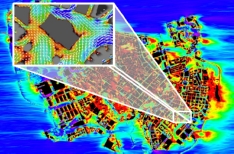| Version 11 (modified by maronga, 9 years ago) (diff) |
|---|
MOSAIK - Model-based city planning and application in climate change, a sub-project of the BMBF funded project "Stadtklima im Wandel"
Within the joint research project MOSAIK a new urban climate model of unprecedented spatial resolution and computational performance will be developed. The core of this new model (working title: ??), will be based on the modern, highly parallelized and optimized large-eddy simulation model PALM(link).

PALM will be extended by
- Reynold-averaged-Navier-Stokes-type turbulence parameterizations for fine and coarse spatial resolution
- components required for urban modeling, like an energy balance solver for different urban surface types, an energy demand model for buildings, and an urban chemistry model.
- a multi-agent model in order to study environmental effects on large groups of people.
- a grid nesting feature to allow forcing by larger-scale models
- self-nesting which will allow to focus on specific areas of interest like small city quarters or single streets.
These features will allow both simulations with very high spatial resolution (down to 1m) for large cities or long climate projections as well as more focused simulations with coarser resolution, and exemplary periods or specific areas (e.g. for city planners) with limited computer resources.
MOSAIK news
MOSAIK NEWS | UPCOMING EVENTS | |
2016-07-16 This years PALM seminar is held at Institute of Meteorology and Climatology, Leibniz Universität Hannover, October 10th - 14th (further information) | 2016-11-08 - 2016-11-09 M-Projects, Hannover |
Attachments (8)
-
titelbild_4.jpg
(1.5 MB) -
added by maronga 9 years ago.
MOSAIK title
-
maronga_v7.png
(1.5 MB) -
added by maronga 9 years ago.
MOSAIK test logo
- maronga_v8.png (2.9 MB) - added by maronga 9 years ago.
- MOSAIK_logo.png (465.2 KB) - added by maronga 9 years ago.
-
PALM-4U_logo.png
(438.9 KB) -
added by kanani 8 years ago.
PALM-4U logo
-
MOSAIK_forgotten_future_normal.png
(1.5 MB) -
added by hettrich 5 years ago.
MOSAIK-2 official logo
- PALM Seminar September 2020.pdf (511.7 KB) - added by hettrich 5 years ago.
- PALM Seminar February 2021.pdf (3.1 MB) - added by hettrich 5 years ago.



